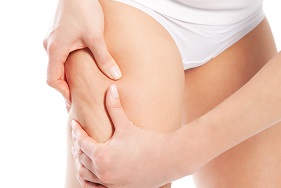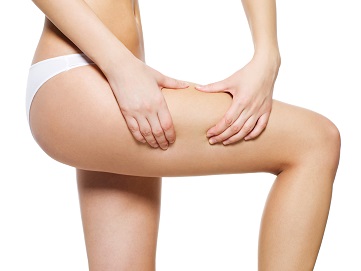Types of cellulite
Aqueous
- Increases water retention
- Increased volume and size
- Appearance of the skin less uniform, less smoot
Lipid
- Accumulation of lipids and water
- Tissue degeneration
- Painful
- Associated with circulatory problems
Triggers of Cellulite
-
Hormonal: puberty, menstruation, pregnancy, contraception, menopause, hypothyroidism ... which affects blood circulation and lipid synthesis.
-
Vascular capillary fragility, loss of elasticity, hardening of the vessels, varicose veins, microtrauma (hematomas).
-
Genetic: gynoid body composition (wide hips), more common in Latin women than Nordic women.
-
Eating Habits: overeating (lipogenesis), excess salt intake(fluid retention), poor water and liquid consumption, poor vegetable consumption, unbalanced and / or poor diet.
-
Lifestyle: sedentary lifestyle, lack of exercise, poor posture, tight clothing, inappropriate footwear and excessive heat, smoking.
Suitable treatments
Given the variety of factors that can lead to the appearance of cellulite, treatment should also address factors:
-
Diet: reduce the consumption of refined sugars, saturated fats + alcohol + to decrease lipogenesis. Decrease salt intake and increase fluids to increase urine output + removing toxins hydration (summer). Increase consumption of raw vegetables (salads and fruit) (rich in fiber and vitamins detoxifying).
-
Changing Habits: engaging in regular exercise (swimming, walking, cycling). Correcting bad posture (excessive time standing or sitting, with legs crossed,). Clothing / suitable footwear (too tight, excessive heels.)
-
Clinical treatments:liposuction, Mesotherapy.
-
Physical treatments: Electrotherapy, Ultrasound, Hydrotherapy, Sauna, Oxygen, Massage.
-
Cosmetic treatments: a good cosmetic treatment to combine three points:
- Massage to stimulate active penetration and lymphatic drainage. The massage should be: circular (belly, abdomen and buttocks), ascending (legs and arms), by hand or mitt and firm but not aggressive.
- Suitable active ingredients selected to perform at three levels:
- Lipolytic -> act at adipose tissue level
- Venotónica -> act at circulatory (draining and invigorating)
- Firming / Restructuring -> act atconjunctive tissue
Daily Application (morning and evening)
Active Ingredients
Caffeine: Stimulates lipolysis in adipocytes. Stimulates the breakdown of triglycerides from adipocytes. Reduces the volume of adipocytes.
Centella asiatica: Promotes the synthesis of collagen. Rigidity prevents elastin fibers of collagen. Promotes tissue repair process.
Ivy and green tea: Improve blood circulation. Facilitate venous return. Facilitate lymphatic drainage.
Seaweed extract: Activates cell metabolism and revitalizes the tissues. It helps eliminate accumulated toxins and fluids.
Carnitine: Reduces high rates of triglycerides and cholesterol. Its deficiency prevents fats from being transported to power plants, where they are burned. Promotes the breakdown of triglycerides in adipose tissue.
 Österreich
Österreich  Bolivia
Bolivia  Brasil
Brasil  България
България  China
China  China - Hong Kong
China - Hong Kong  Colombia
Colombia  Costa Rica
Costa Rica  Česká republika
Česká republika  Dominicana
Dominicana  USA
USA  El Salvador
El Salvador  France
France  Deutschland
Deutschland  Guatemala
Guatemala  India
India  Éire
Éire  Italia
Italia  Lëtzebuerg
Lëtzebuerg  Malta
Malta  المغرب
المغرب  Mexico
Mexico  Nederland
Nederland  Panama
Panama  Peru
Peru  Polska
Polska  Portugal
Portugal  România
România  Россия
Россия  España
España  China - 台湾
China - 台湾  الجمهورية التونسية
الجمهورية التونسية  Türkiye
Türkiye  United kingdom
United kingdom  International
International 








